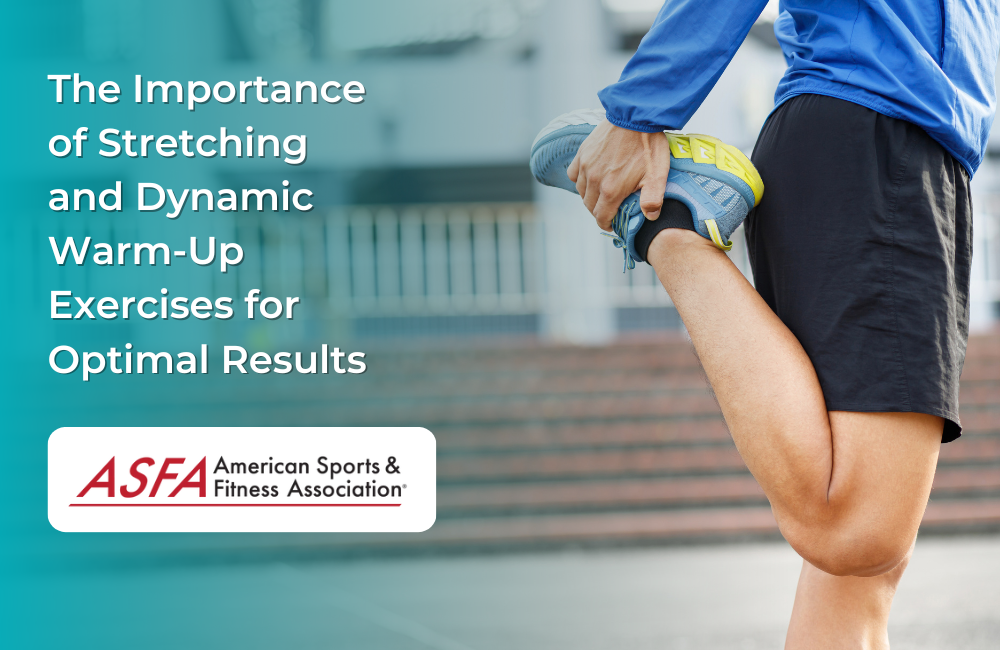Stretching and dynamic warm-up exercises are essential components of any fitness routine, yet are often overlooked or neglected. By taking the time to stretch and do a dynamic warm-up before each workout, you can not only reduce the risk of injury but also improve your performance and maximize your results. In this blog post, we'll explore the importance of stretching and dynamic warm-up exercises for optimal results.
What is stretching?
Stretching is an important part of any workout routine, and it is essential for maintaining flexibility. Stretching is a type of physical exercise that involves lengthening the muscles and tendons in order to increase their range of motion. It’s typically done through movements such as reaching, bending, and twisting, as well as holding a particular position for a certain amount of time. Stretching can be done with or without equipment, and it is usually done before and after workouts in order to improve flexibility and reduce the risk of injury. Stretching also increases blood flow to the muscles, which helps them recover quickly after strenuous activities.
What are the benefits of stretching?
Stretching is an essential part of any exercise routine and is a great way to improve performance and reduce injury. Stretching helps to increase flexibility and range of motion, which allows your muscles to work more efficiently and increase your athletic performance. Increased flexibility can also help to reduce the risk of muscle strain or injury as well as improve your posture. Additionally, stretching can also help to reduce stress, anxiety, and fatigue.
Stretching also helps to improve your balance and coordination, which can help you prevent falls and stay safe while performing physical activities. Improved flexibility can also enhance your body’s ability to recover from a workout faster and help reduce soreness. This can lead to improved mental clarity and better overall health.
Overall, the benefits of stretching are numerous. Regular stretching can help to keep your muscles flexible, improve your athletic performance, reduce the risk of injury, and promote a sense of well-being. Incorporating stretching into your workout routine is an important part of any physical fitness program and can help you unlock your body’s full potential by increasing your flexibility.
How can I make sure I'm stretching correctly?
Stretching is an important part of any exercise routine and it's important to make sure you're doing it correctly. Stretching should always be done slowly, never with jerky motions. Make sure to warm up before stretching to reduce the risk of injury. Always stretch to the point of tension, but never to the point of pain.
It's best to focus on stretching one muscle group at a time, rather than trying to stretch multiple areas at once. Hold each stretch for at least 15-30 seconds, and release gradually. Breathe deeply and don’t bounce or jerk while stretching. Keep your movements smooth and slow.
When stretching, make sure that you are keeping your body in proper alignment and posture. Don’t arch your back or slouch forward, and keep your abdominals engaged and your neck in line with the rest of your spine. If you feel discomfort or pain during a stretch, ease up or stop the movement.
Finally, be consistent! Set aside time each day for stretching and dynamic warm-up exercises. Doing this regularly will help you to improve your flexibility and range of motion, which can help you get better results from your workout.
What are some dynamic warm-up exercises I can do?
Dynamic warm-up exercises are movements that prepare the body for physical activity by gradually increasing the heart rate and body temperature, as well as improving range of motion. They’re an important component of a healthy fitness routine, as they help to reduce the risk of injury and improve performance.
Some great dynamic warm-up exercises to get started include:
- High knees - This exercise involves jogging on the spot and lifting each knee up to your chest as you go. It helps to warm up your lower body and core muscles, as well as increase your range of motion.
- Butt kicks - Just like with high knees, butt kicks involve jogging on the spot but this time lifting your heels up behind you instead of bringing them up to your chest. It helps to stretch out your hamstrings, calves, and hip flexors.
- Arm swings - To perform this exercise, stand with your feet shoulder-width apart and swing both arms forwards and backwards in a controlled manner. This helps to loosen up your shoulders, chest, back, and arms.
- Lunges - Start in a standing position and take a big step forward with one foot. Lower your hips until both knees form 90-degree angles, then push off with your front foot to return to standing. This exercise helps to improve balance, flexibility, and strength in your legs.
By incorporating these dynamic warm-up exercises into your fitness routine you can ensure that you’re adequately preparing your body for physical activity and giving yourself the best chance for optimal performance and injury prevention.
How often should I stretch and do dynamic warm-up exercises?
The amount of time and frequency that one should dedicate to stretching and dynamic warm-up exercises will vary from individual to individual depending on their goals, level of physical activity and any existing conditions or injuries. However, in general, it is recommended to stretch for 5 to 10 minutes before and after any workout or physical activity. Dynamic warm-up exercises can be done daily as part of an active lifestyle, or before any physical activity such as sports or exercise.
For the best results, athletes and fitness enthusiasts should develop a regular stretching routine that focuses on improving range of motion and flexibility, while also including dynamic warm-up exercises to help increase blood flow to muscles and prepare the body for exercise. A combination of static stretches and dynamic exercises that target the muscles used in the activity you are doing will help ensure your body is properly prepared for activity. Finally, it is important to listen to your body and not push it too hard. If something feels uncomfortable or painful, stop and focus on the areas that need extra attention.




